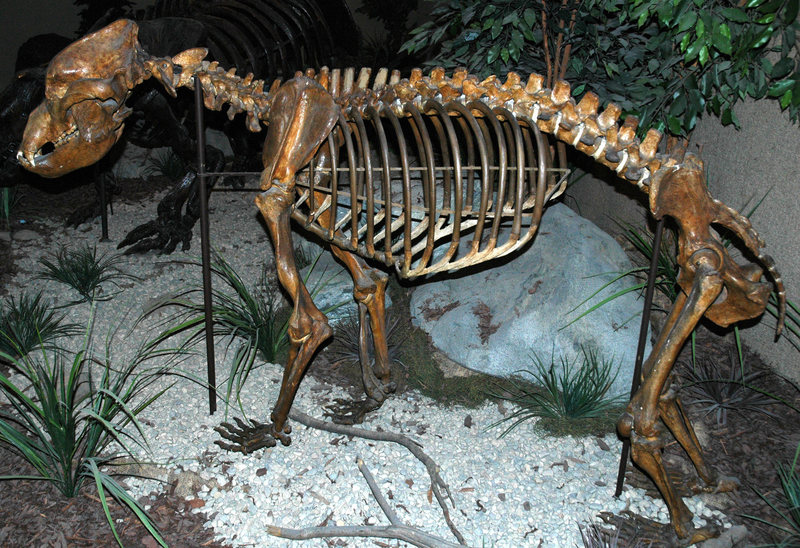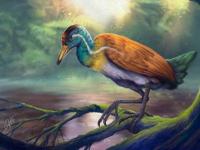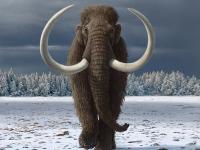Paleontologists Are Trying to Understand Why the Fossil Record Is Mostly Males

One theory is that reckless young bison and mammoths got into more trouble.
FOR ANCIENT MAMMALIAN MEGAFAUNA—FROM BROWN bears to bison and more—death was something of a boy’s club. At least that’s what you might conclude from the vaults of natural history museums around the world, where the majority of fossilized mammal specimens come from males.
This has less to do with misogyny than with prehistoric herd distributions, sex-specific causes of death, and a slew of other factors that influenced where and how large mammals tended to die, according to a study published September 3 in Proceedings of the National Academy of Sciences.
Researchers from the University of Adelaide in Australia first identified this strange trend after analyzing ancient DNA in specimens in their own collection, according to Graham Gower, a genomic programmer and a coauthor of the study. There are a few ways to sex an ancient bone. If you’re lucky enough to have a whole bone, such as a skull, the size, shape, and dimensions might differ between male and female. In the case of fragments, researchers might have to dig into DNA for the number of X-chromosome sequences, Gower says. But usable DNA is scarce in most specimens that old. From approximately 20,000 samples, Gower says, the researchers got usable DNA from 5 percent.
After analyzing seven samples of ancient bison bone for another study, Gower noticed most were male. This puzzled him, so he asked a colleague if he could look at her samples. By the time he got up to 25 or 30, the bias was clear. “Seventy-five percent of them were male,” he says.
Later in 2017, researchers from the Swedish Museum of Natural History published a paper in Current Biology confirming the bias Gower had seen. Led by biologist Patrícia Pečnerová, the researchers sexed 95 sets of mammoth remains and found that a surprising 69 percent were males. Like Gower, Pečnerová’s team did not set out to study sex discrepancies in fossil collections. They were working on a larger project on the genomes of woolly mammoth populations to learn more about how the animals behaved and socialized in the last 60,000 years before their extinction.
The researchers were stunned by what they saw. No one had expected to find so substantial a bias in the fossil record, as there were no indications that the ratio of females to males in mammoth populations was unbalanced at birth. They figured it was more probable that young male mammoths were much more likely to travel solo, away from the wisdom and protection of matriarchal herds, similar to the way elephant societies function today. In other words, these male mammoths—young, reckless, foolhardy—were just more likely to get into some kind of trouble and die, from getting stuck in a pit to running afoul of hunting humans. Luckily for paleontologists, some of these death sites—bogs, crevices, lakes—are pretty good at preserving remains. “They were more likely to do silly things, like die in tar pits,” Gower says.
“In this type of research, there is some inherent level of speculativeness because we have to put together different types of evidence and find the most parsimonious explanation,” Pečnerová explains in an email. “We cannot go out and observe how extinct species behave and how they live.”
When Gower’s team read the Current Biology paper, they decided to dig deeper. They expanded the scope of species to include brown bears. Gower and his fellow researchers sexed the remains of 186 Holarctic bison and 91 Arctic brown bears.
They found 75 percent of bison fossils in such collections were males. This wasn’t a surprise, based on what Pečnerová had theorized about mammoth herd behavior, since bison social structure similarly isolates young males. “By [the mammoth] anology, some of the male bison are going off and doing stupid things,” Gower says, adding that the researchers were not able to test for age to further support the theory, but he hopes to in the future.
Among the brown bear populations, two thirds were male, and this was a little more surprising. Bears don’t herd. “In America, you might observe a group of brown bears in Yellowstone congregating around a garbage bin, but they’re usually on their own,” Gower says. They would have to consider other behavioral differences that might explain the discrepancy. The researchers theorize that males had much larger ranges than females, so they died across a wider area and range of environments, which in turn made their fossils more easily discoverable by humans. The sex discrepancy thinned out for specimens collected at higher altitude, where food is more scarce and females subsequently have larger ranges. Pečnerová says she was surprised by these findings, as bear populations tell a very different story than do mammoths and steppe bison. “However, if you give it more thought,” she says, “it makes perfect sense.”
The researchers also counted male and female specimens in the online databases of four of the largest natural history museums in the world: the American Museum of Natural History in New York, the Natural History Museum in London, the Smithsonian Institution National Museum of Natural History in Washington, D.C., and the Royal Ontario Museum. These specimens were collected some time during the past hundred years, mostly through hunting and trapping.
They found the same bias in all but a few mammalian orders, with bats, sloths, and anteaters among the exceptions. All three of those had more females than males. In the case of the bats, the researchers theorize the bias may be due to collections that derive from single roosts. During certain parts of the year, a roost might be occupied by maternity colony, an all-female group of bats in various stages of birthing, nursing, and weaning their pups. The largest modern bat maternity colony in the world roosts in Texas’s Bracken Cave and produces millions of pups each year. In the case of sloths and anteaters, the jury’s still out.
The researchers all toyed with another theory: Were collectors decades ago just more likely to seek out larger, more impressive fossil trophies, which would tend to show a preference for males? This kind of bias is clear in modern ornithological collections, where flamboyantly plumed male birds vastly outnumber their more modest female counterparts. According to Gower, sexual dimorphism—significant anatomical differences between male and female individuals of a single species—is apparent in the skulls of ancient beasts such as mammoths and bison, so it’s possible that male remains were more desirable finds. But analysis of the number of samples that display clear sexual dimorphism didn’t offer clear results.
While these biases certainly generate interesting theories about Pleistocene behavior (and modern human behavior), they create very real problems for science based on museum collections. These specimens are one of the largest sources of data for understanding the anatomy, variability, diet, range, and more of long-extinct animals. And if that’s the case, much of what we know about these creatures comes from a population that’s not reflective of reality. Accordingly, the paper suggests that, when possible, museum curators should choose specimens or seek more balanced collections to represent both sexes, as well as a range of localities, ages, and time periods.
Until then, it’s a lonely world for female mammoth, bison, and brown bear fossils.
Source: www.atlasobscura.com











